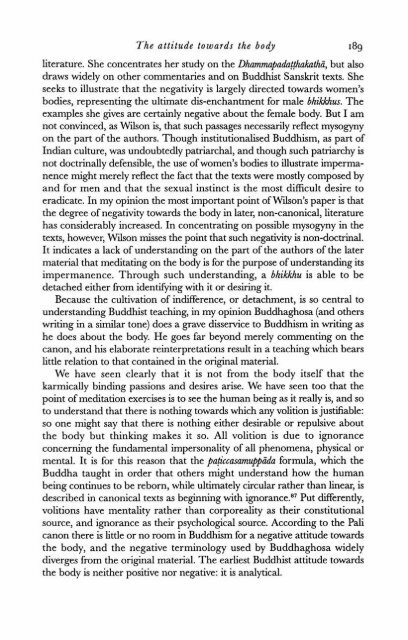Identity and Experience_Hamilton_1996
Identity and Experience_Hamilton_1996
Identity and Experience_Hamilton_1996
Create successful ePaper yourself
Turn your PDF publications into a flip-book with our unique Google optimized e-Paper software.
The attitude towards the body 189<br />
literature. She concentrates her study on the Dhammapadat.thakuthti, but also<br />
draws widely on other commentaries <strong>and</strong> on Buddhist Sanskrit texts. She<br />
seeks to illustrate that the negativity is largely directed towards women's<br />
bodies, representing the ultimate dis-enchantment for male bhikkhus. The<br />
examples she gives are certainly negative about the female body. But I am<br />
not convinced, as Wilson is, that such passages necessarily reflect mysogyny<br />
on the part of the authors. Though institutionalised Buddhism, as part of<br />
Indian culture, was undoubtedly patriarchal, <strong>and</strong> though such patriarchy is<br />
not doctrinally defensible, the use of women's bodies to illustrate impermanence<br />
might merely reflect the fact that the texts were mostly composed by<br />
<strong>and</strong> for men <strong>and</strong> that the sexual instinct is the most difficult desire to<br />
eradicate. In my opinion the most important point of Wilson's paper is that<br />
the degree of negativity towards the body in later, non-canonical, literature<br />
has considerably increased. In concentrating on possible mysogyny in the<br />
texts, however, Wilson misses the point that such negativity is non-doctrinal.<br />
It indicates a lack of underst<strong>and</strong>ing on the part of the authors of the later<br />
material that meditating on the body is for the purpose of underst<strong>and</strong>ing its<br />
impermanence. Through such underst<strong>and</strong>ing, a bhikkhu is able to be<br />
detached either from identifying with it or desiring it.<br />
Because the cultivation of indifference, or detachment, is so central to<br />
underst<strong>and</strong>ing Buddhist teaching, in my opinion Buddhaghosa (<strong>and</strong> others<br />
writing in a similar tone) does a grave disservice to Buddhism in writing as<br />
he does about the body. He goes far beyond merely commenting on the<br />
canon, <strong>and</strong> his elaborate reinterpretations result in a teaching which bears<br />
little relation to that contained in the original material.<br />
We have seen clearly that it is not from the body itself that the<br />
karmically binding passions <strong>and</strong> desires arise. We have seen too that the<br />
point of meditation exercises is to see the human being as it really is, <strong>and</strong> so<br />
to underst<strong>and</strong> that there is nothing towards which any volition is justifiable:<br />
so one might say that there is nothing either desirable or repulsive about<br />
the body but thinking makes it so. All volition is due to ignorance<br />
concerning the fundamental impersonality of all phenomena, physical or<br />
mental. It is for this reason that the pa.ciccasamuppiida formula, which the<br />
Buddha taught in order that others might underst<strong>and</strong> how the human<br />
being continues to be reborn, while ultimately circular rather than linear, is<br />
described in canonical texts as beginning with ignorance.*' Put differently,<br />
volitions have mentality rather than corporeality as their constitutional<br />
source, <strong>and</strong> ignorance as their psychological source. According to the Pali<br />
canon there is little or no room in Buddhism for a negative attitude towards<br />
the body, <strong>and</strong> the negative terminology used by Buddhaghosa widely<br />
diverges from the original material. The earliest Buddhist attitude towards<br />
the body is neither positive nor negative: it is analytical.


